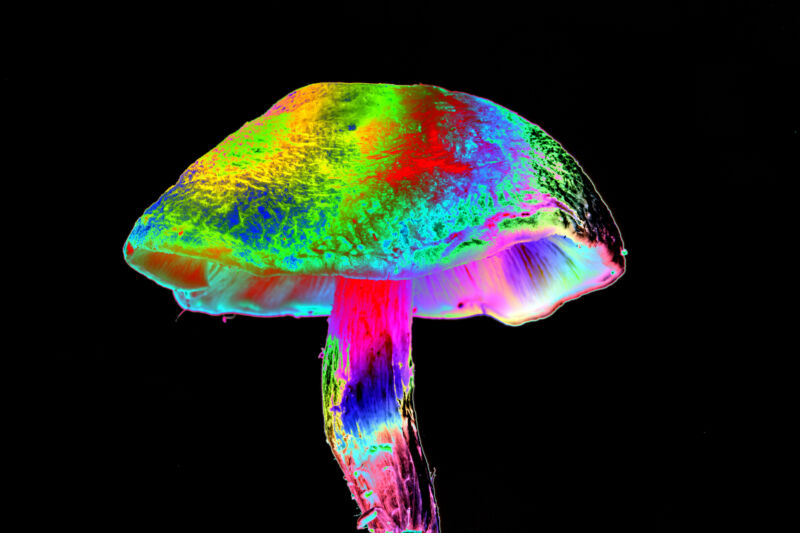Psychedelic drugs are often used for entertainment purposes. But there have been some recent indications that they can be effective against PTSD and treatment-resistant depression. Figuring out whether these substances work as medicinal drugs can be challenging because (as one researcher helpfully pointed out) it's difficult to do a controlled experiment when it's easy to figure out who's in the treatment group. Still, we've made some progress in understanding what's happening with psychedelics at the molecular level.
Many psychedelics seem to bind to a specific receptor for the neural-signaling molecule serotonin, activating it. That would seem to make sense for antidepressive effects, given that many popular antidepressants also alter serotonin signaling (such as in SSRIs, or selective serotonin reuptake inhibitors). But SSRIs don't produce any of the mind-altering effects that drive non-medical interest in psychedelics, so things remain a bit confusing.
New data suggests that psychedelics may activate serotonin signaling in a very different way than serotonin itself can, reaching the receptors in parts of the cell that serotonin can't get to.
Good reception
Serotonin signaling is complicated. There are seven classes of receptors in humans; some activate signaling pathways, while others inhibit them. One group of receptors allows ions into a cell in response to serotonin, triggering nerve impulses. The rest interact with proteins inside the cell, triggering longer-term responses to serotonin. Psychedelics such as LSD and mescaline bind to members of this latter group and activate it.
This action produces some rather dramatic changes in how people perceive their surroundings. But there's also some evidence that psychedelics promote changes to nerve cells that allow these cells to alter their connectivity. This occurs by causing the structures that receive input from other nerve cells, called dendrites, to grow and branch, potentially allowing additional or altered inputs. One hypothesis is that this altered connectivity allows cells to escape whatever network configuration has been associated with a medical disorder.
The researchers confirmed these results using DMT, a psychedelic found in ayahuasca, and psilocin, the active form of the drug psilocybin, which is typically obtained from mushrooms. Twenty-four hours after mice received one of these drugs, nerve cells in their brains had an increased density of extensions from their dendrites. This growth was accompanied by an increased frequency of activity in individual nerve cells. Running the same tests in mice that lacked the gene for the specific serotonin receptor that these drugs target blocked both of these effects, confirming that serotonin signaling is central to the changes.
The researchers then started testing close chemical relatives of the drugs and saw a clear pattern: Making the drug less likely to interact with water boosted their effects on neurons. This suggested that the ability to cross membranes, which are very water-repellant, might be needed to promote changes in dendrites. To confirm this, the researchers poked holes in the membranes, which boosted the activity of water-friendly drug variants that wouldn't readily cross the membrane.
This is all a bit confusing because the serotonin receptors sit inside the membrane and interact with the cell's exterior. They have to—that's where the serotonin is. So why would anything that interacted with those receptors need to cross a membrane to the cell's interior?
Keeping it inside
The receptors on the cell's surface are definitely key to the cell's response to serotonin. But the receptors don't just magically appear on the cell's surface—they're made elsewhere in the cell and take a while to be processed and transported to the surface. The researchers found a population of serotonin receptors sitting inside a structure called the Golgi. It's not clear whether this population is simply on its way to the cell surface or whether it's retained there by some specific biological activity.
Normally, these receptors wouldn't come into contact with serotonin, so they wouldn't signal from this location. But the researchers modified a protein to make it pump serotonin inside of cells and showed that it had the same effect the psychedelics had, suggesting the receptors could be activated and that this activation was key to altering neural connectivity.
Does this have anything to do with the medical effects of psychedelics? Tests with mice that had this internal serotonin signaling active in their brains showed that the mice were less likely to show behaviors considered to be analogs of depression.
While suggestive, this study doesn't definitively show that this internal population of serotonin receptors is needed for the therapeutic responses to psychedelics. None of this evidence addresses whether these receptors are involved in the actual psychedelic response to these drugs, either. So the findings should be viewed more as a hint of something worth looking at further than as a clear demonstration of an important feature of neurobiology.
Another big question: If serotonin doesn't reach these internal receptors, do they have a normal function at all? One intriguing possibility is that the DMT tested here is what activates them. The drug is also produced in humans, albeit at much lower levels than it's found in some plants. So there's a chance the mechanism revealed here is normally a part of brain function.
Science, 2023. DOI: 10.1126/science.adf0435 (About DOIs).



3175x175(CURRENT).thumb.jpg.b05acc060982b36f5891ba728e6d953c.jpg)

Recommended Comments
There are no comments to display.
Join the conversation
You can post now and register later. If you have an account, sign in now to post with your account.
Note: Your post will require moderator approval before it will be visible.